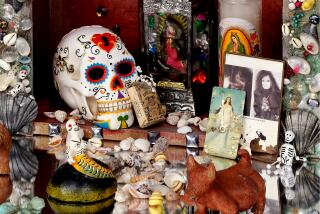Rare Inuit portraits by Henri Matisse displayed for first time in the U.S.
âYua: Henri Matisse and the Inner Arctic Spirit,â which opened Monday at the Heard Museum in Phoenix, tells several stories, not the least of which is the unusual pairing of the French artistâs Inuit portraits and traditional Native Alaskan masks. Matisse is one of the few non-Native Americans whose work is being highlighted at the museum dedicated to Native American art.
Itâs a one-of-a-kind exhibition that marks the first time Matisseâs Inuit portraits have been displayed in the U.S. It also marks the first time in more than a century that masks, often created in pairs or sets by the Yupik, one of the indigenous Alaskan peoples, have been reunited.
But back to Matisse.
âI first learned about the story in 1998, when I met a member of the Matisse family,â said the museumâs director and chief executive, David Roche. âIt was and remains a little-known story in the broader scope of art history.â
The portraits are likely as little known as the masks made by Yupiks, one of the indigenous Alaskan peoples, which were traditionally used in performances to tell rich spiritual stories dominated by animals and nature.
After World War II, Matisseâs son-in-law, Georges Duthuit, an art critic and collector in New York City, had Yupik masks and other artifacts brought them to France. Duthuit and the artistâs daughter, Marguerite, asked Matisse to illustrate a book they had planned about the Arctic. He made 50 illustrations, among them the portraits.
Roche thinks the French artist, upon seeing the native art, immediately connected with the shamans who made them. âI think when Matisse saw these masks, he found kindred spirits, [people] who made these halfway across the world.â Some would have been the artistâs contemporaries.
Matisse sketched the faces not from the masks but from photographs of Inuits from the fifth Thule expedition to the Arctic in the early 1920s led by Knud Rasmussen.
His work will now be displayed side-by-side with photos and artifacts of early Arctic dwellers. The word âyuaâ in the exhibitionâs title, by the way, refers to âthe spiritual interconnectedness of all living thingsâ that keeps life in balance, according to a museum news release.
Sean Mooney, who co-created the show with Yupik artist and elder Chuna McIntyre, said the storytelling masks were separated in the early 20th century when Gold Rush-era treasure hunters turned to collecting them and selling them to museums.
Through the masks, Mooney said, âyou invoke the spirit of those animals to return to you in spring so you can survive next year.â In a series of wind-talking masks known as the four winds, only three had ever been reunited and displayed together. That was until McIntyre found the missing fourth while doing research at UCLAâs Fowler Museum.
The Heard Museum will be the only place to see this show, which partnered with the Matisse Museum in Le Cateau-Cambrésis, France, the Metropolitan Museum of Art in New York City, the Fowler Museum and others.
The show runs through Feb. 3. Tickets cost $25 for museum admission and the exhibition.
Info: The Heard Museum, 2301 N. Central Ave., Phoenix; (602) 252-8840
More to Read
Sign up for The Wild
Weâll help you find the best places to hike, bike and run, as well as the perfect silent spots for meditation and yoga.
You may occasionally receive promotional content from the Los Angeles Times.







